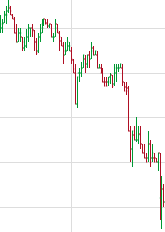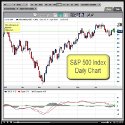This article is part of the Trend Technician Technical Analysis Basics series. Be sure to read the rest of the series.
Once we understand the concepts of support and resistance we can talk about the two basic states a trend can be in: A trading range and a trend.

A Downtrend -- Note the lower highs as well as the lower lows.
A trend exists when prices are moving in a direction. When prices are consistently becoming higher, you are in an uptrend and when prices are consistantly lower you are in a downtrend. This distinction may sound arbitrary but the basic definition is that when prices are reaching higher highs and higher lows then the price is moving upwards and vice versa for downwards. When prices are not trending they are considered to be in a trading range. In this state, most prices hit roughly the same highs and the same lows.
Obviously these defintions only make sense in terms of a timespan. A particular issue can be in a long-term uptrend, but a short term downtrend. This is usually defined by what time period a bar represents on a graph and what kind of timespan in which you are planning on executing your trade. Moreover traders oftentimes tend to avoid issues when they are in a trading range, however this can be a great opportunity to profit using options.
Trading Trends and Trading Ranges
The rules of trading trends are fairly obvious. You very rarely want to trade against the trend for the timespan in which you are investing. While you might trade against a long-term trend if you plan on holding for only a short period of time, or against a short-term trend if you’re planning on holding for a long period of time, typically you want to trade with the trend. Additionally, profit taking can be very difficult in trading ranges.



Write a Comment